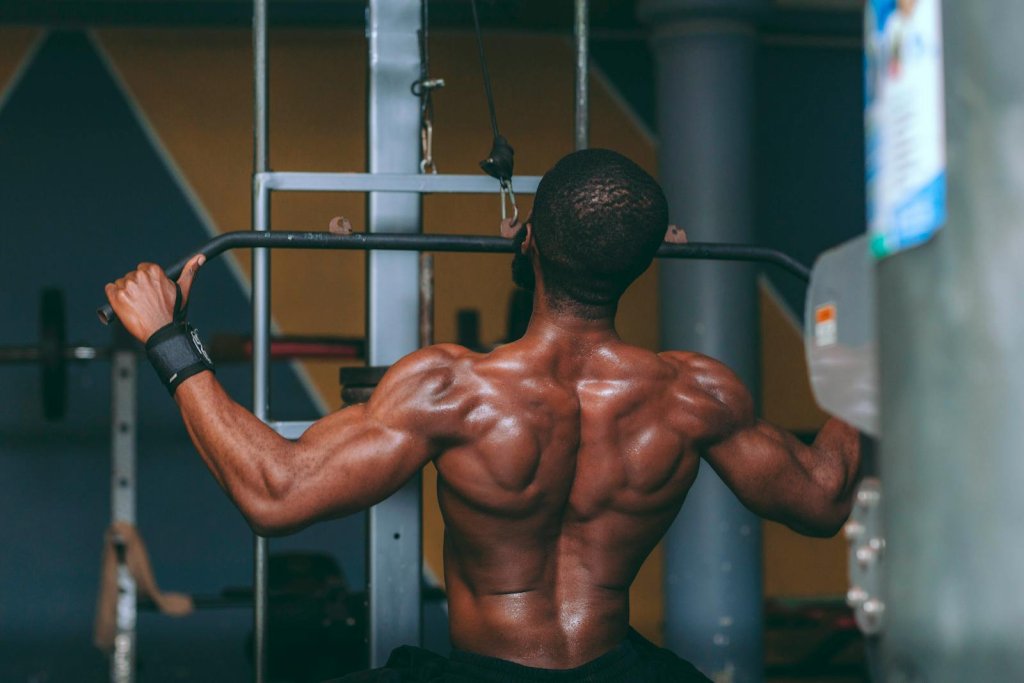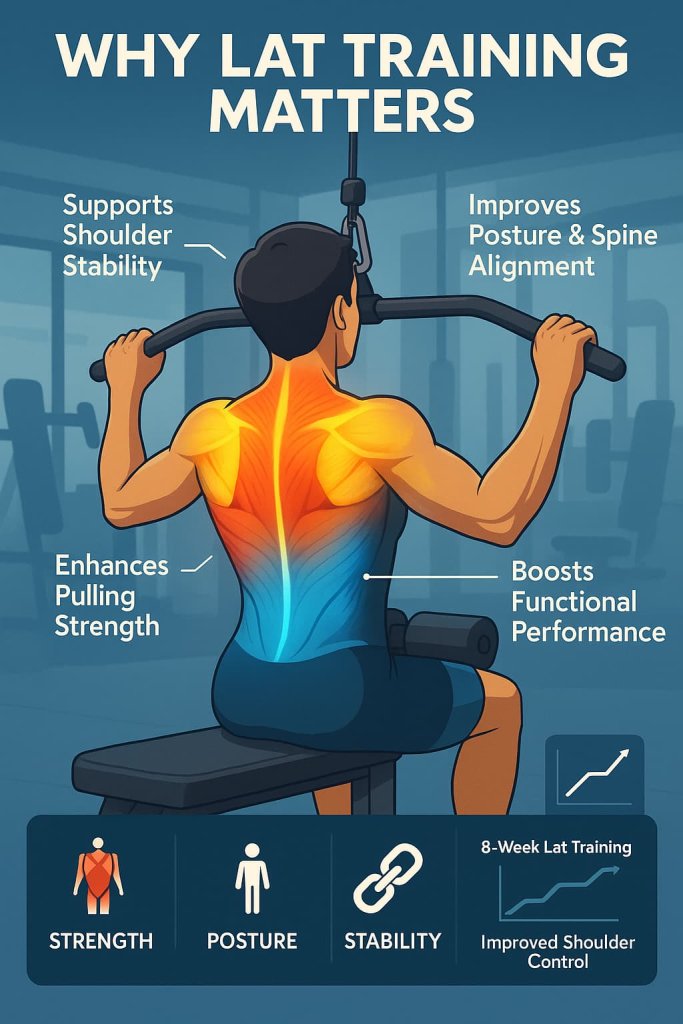The best way to build a wider, more defined back is to target your lats—the large muscles that create the iconic V-shape.
The latissimus dorsi (or “lats”) connect your upper arms to your spine and pelvis, playing a key role in posture, pulling strength, and overall back aesthetics. Understanding how to activate and strengthen them correctly can dramatically improve your physique, reduce shoulder strain, and boost performance in all upper-body movements.

In this guide, you’ll discover 12 of the most effective lat exercises, from bodyweight classics to machine-based movements, backed by current research and biomechanics.
Why Lat Training Matters
Strong lats do far more than enhance your physique. They:
- Stabilize your shoulders and spine during heavy lifts.
- Improve posture and reduce upper-back pain.

- Boost performance in pull-ups, rows, and even bench presses.
- Contribute to balanced upper-body symmetry.
A 2024 trial reported that eight weeks of lat-pulldown training performed under joint instability improved pull-up endurance and reduced antagonist co-activation in trained students, indicating better pulling performance and shoulder control.
12 Best Lat Exercises to Build a Wider Back
These 12 lat exercises combine proven compound and isolation movements to build a wider, stronger, and more defined back.
They target every angle of the latissimus dorsi for balanced development, improved posture, and superior pulling power.
1. Pull-Up
Why it works:
The ultimate test of back strength, the pull-up builds significant lat width through vertical pulling and engages multiple stabilizers for complete upper-body development. It’s one of the few exercises that effectively loads the lats through a long range of motion using only bodyweight.
Muscles worked:
Latissimus dorsi, biceps brachii, rear deltoids, rhomboids, and trapezius.
How to do it:
- Grip a pull-up bar slightly wider than shoulder width, palms facing away.
- Start from a dead hang with your shoulders engaged and core tight.
- Pull your chest toward the bar by driving elbows down and back.
- Pause at the top briefly, then lower slowly under control until arms are fully extended.
Trainer Tip:
If full pull-ups are too difficult, use an assisted pull-up machine or resistance bands. Focus on controlled eccentrics (slow lowering) to build strength faster.
2. Chin-Up
Why it works:
A variation of the pull-up that emphasizes biceps and lower-lat involvement. The supinated (underhand) grip allows for greater arm flexor contribution, improving pulling power and lat engagement.
Muscles worked:
Lats, biceps, teres major, and core stabilizers.
How to do it:
- Grab the bar shoulder-width apart with palms facing you.
- Hang with arms extended and engage your core.
- Pull your chin above the bar by driving elbows down.
- Lower slowly with control.
Trainer Tip:
Keep your elbows tucked close to your sides for optimal lat activation. Avoid jerking or swinging.
3. Lat Pulldown
Why it works:
A controlled, machine-based exercise that mimics the pull-up while allowing precise resistance adjustments. Ideal for hypertrophy and beginners developing strength for full pull-ups.
Muscles worked:
Lats, biceps, posterior deltoids, and traps.
How to do it:
- Sit down and grip the bar slightly wider than your shoulders.
- Pull the bar toward your upper chest, squeezing shoulder blades together.
- Pause briefly, then return to the start position in a slow, controlled motion.
Trainer Tip:
Keep your torso nearly vertical — excessive leaning turns this into a row.
Research insight:
A 2023 NASM study found that medium to wide grips enhance lat activation compared to narrow grips.
4. Bent-Over Barbell Row
Why it works:
A powerful mass builder that targets the mid and upper back. It develops horizontal pulling strength and builds thickness across the lats and rhomboids while training spinal stability.
Muscles worked:
Lats, rhomboids, posterior deltoids, traps, erector spinae.
How to do it:
- Hold a barbell with a pronated (overhand) grip, shoulder-width apart.
- Bend at the hips to about a 45° angle, keeping the spine neutral.
- Pull the bar toward your lower ribs, squeezing your shoulder blades together.
- Lower the bar under control.
Trainer Tip:
Keep your core tight and avoid rounding your back. Imagine pulling the bar “through” your torso to fully recruit the lats.
5. Single-Arm Dumbbell Row
Why it works:
Unilateral training improves symmetry and coordination while allowing a greater range of motion for the lats. It’s easier on the lower back compared to barbell versions.
Muscles worked:
Lats, rhomboids, traps, posterior deltoids.
How to do it:
- Place one knee and one hand on a flat bench.
- Hold a dumbbell in the opposite hand with a neutral grip.
- Pull the dumbbell toward your hip, keeping your elbow close to your body.
- Lower slowly until your arm is straight.
Trainer Tip:
Avoid twisting your torso—keep it square to the floor. Focus on driving your elbow rather than your hand to activate the lats fully.
6. Seated Cable Row
Why it works:
Delivers consistent resistance throughout the range of motion and minimizes lower-back strain. Perfect for building mid-back density and improving scapular control.
Muscles worked:
Lats, rhomboids, traps, biceps, posterior deltoids.
How to do it:
- Sit upright with your feet braced and knees slightly bent.
- Grip the handle with both hands and pull toward your lower ribs.
- Squeeze shoulder blades together at the end range.
- Return slowly to full arm extension.
Trainer Tip:
Maintain a neutral spine; do not lean back excessively. A brief pause at full contraction enhances lat engagement.
7. Inverted Row
Why it works:
A bodyweight move that strengthens lats and scapular retractors while improving posture. Great for beginners or as an accessory lift for advanced athletes.
Muscles worked:
Lats, traps, rhomboids, rear deltoids, biceps.
How to do it:
- Set a barbell in a rack at waist height or use TRX straps.
- Lie underneath and grab the bar with an overhand grip.
- Keep your body in a straight line and pull your chest to the bar.
- Lower back down slowly without sagging your hips.
Trainer Tip:
To make it harder, elevate your feet or add weight with a vest.
8. Straight-Arm Pulldown
Why it works:
This isolation exercise targets the lats through shoulder extension without biceps interference—excellent for establishing a strong mind-muscle connection.
Muscles worked:
Lats, teres major, posterior deltoids.
How to do it:
- Attach a straight bar to a high cable pulley.
- Stand facing the machine, arms straight and slightly wider than shoulder width.
- Pull the bar down in an arc until it touches your thighs.
- Slowly return to the starting position with control.
Trainer Tip:
Keep your arms locked and focus on moving from your shoulders, not your elbows.
9. Machine Row
Why it works:
Allows heavy, stable pulling without spinal stress. Excellent for safely overloading the lats while maintaining strict form.
Muscles worked:
Lats, traps, rhomboids, posterior deltoids.
How to do it:
- Sit upright and grasp the handles with a neutral or overhand grip.
- Pull the handles toward your torso until elbows pass your body line.
- Hold for a second at the top before slowly releasing.
Trainer Tip:
Control the eccentric (lowering) phase to maximize time under tension and muscle growth.
10. Kroc Row
Why it works:
A high-intensity dumbbell row variation combining strength and endurance. Ideal for athletes seeking power and grip development while adding back thickness.
Muscles worked:
Lats, traps, rhomboids, forearms, grip stabilizers.
How to do it:
- Use a heavy dumbbell and support yourself on a bench with one hand.
- Row explosively for 12–20 reps, maintaining good form.
- Allow a slight torso swing to handle the heavier load.
Trainer Tip:
Keep the motion powerful but controlled—avoid jerking. Focus on achieving a full stretch at the bottom of each rep.
11. Dumbbell Pullover
Why it works:
A classic move that stretches and strengthens the lats while enhancing chest and rib cage expansion. Promotes shoulder mobility and deep muscle fiber recruitment.
Muscles worked:
Lats, chest (pectoralis major), triceps.
How to do it:
- Lie on a bench holding a dumbbell above your chest.
- Lower the weight behind your head in a smooth arc.
- Stretch fully, then pull it back using your lats—not your arms.
Trainer Tip:
Avoid bending your elbows too much. Move slowly for maximum stretch and contraction control.
12. Meadows Row
Why it works:
Named after bodybuilder John Meadows, this landmine-style row challenges the lats through an angled pull, emphasizing the lower and outer fibers.
Muscles worked:
Lats, traps, rhomboids, rear deltoids.
How to do it:
- Stand perpendicular to a loaded barbell anchored in a landmine base or corner.
- Grip the sleeve with one hand using a pronated grip.
- Pull the bar toward your hip, keeping your torso stable.
- Lower under control.
Trainer Tip:
Angle your torso slightly forward and maintain tension at the bottom. Keep the motion smooth and powerful—avoid yanking the bar.
Programming Tips for Maximum Lat Growth
- Train 2–3 times per week.
- Combine vertical (pull-up, pulldown) and horizontal (row) movements.
- Use progressive overload—increase reps or weight weekly.
- Include stretch-focused work (like pullovers) for mobility and hypertrophy.
- Rest 48 hours between back sessions for recovery.
Common Mistakes to Avoid
- Using excessive momentum during rows or pulldowns.
- Shrugging shoulders instead of pulling with elbows.
- Overtraining without proper rest.
- Ignoring posture—rounded shoulders can weaken lat activation.
Safety and Precautions
Train smart to protect your back and shoulders:
- Warm up 5–10 minutes before starting.
- Keep your spine neutral—no rounding or arching.
- Move with control; avoid jerking the weight.
- Use full range without overloading.
- Switch grips if shoulders or elbows hurt.
- Progress slowly and rest 48 hours between sessions.
- Stop if pain occurs and check your form.
Proper form keeps your lats growing safely.
FAQ
1. What’s the best exercise for lat width?
Pull-ups and wide-grip pulldowns are best for width due to vertical pulling mechanics.
2. How often should I train lats?
2–3 sessions per week with at least one rest day between.
3. Can I build lats at home?
Yes — with resistance bands, pull-up bars, and dumbbells (e.g., rows, band pulldowns).
4. Should I go wide or narrow grip?
Wide grips emphasize outer lats, while narrow grips hit inner lats and biceps.
5. Why can’t I feel my lats during workouts?
Use isolation moves like straight-arm pulldowns to develop better mind-muscle connection.
6. Are pull-ups better than lat pulldowns?
Pull-ups build real-world strength; pulldowns allow scalable load control for hypertrophy.
7. How long to see results?
With consistency and proper nutrition, noticeable lat development occurs within 6–8 weeks.
Conclusion
Building wider, stronger lats isn’t just about aesthetics—it improves posture, power, and athletic performance. By combining compound and isolation moves, maintaining good form, and progressing over time, you’ll unlock the V-taper back that defines a complete physique.
Start with 3–4 of these exercises per workout and progress weekly.
References
- Latissimus Dorsi — Anatomy & Function (StatPearls, 2023)
https://www.ncbi.nlm.nih.gov/books/NBK448120/ - Grip Width in the Lat Pulldown (Andersen et al., J Strength Cond Res, 2014)
https://pubmed.ncbi.nlm.nih.gov/24662157/ - Forearm Orientation & Grip in Pulldown (Lusk et al., J Strength Cond Res, 2010)
https://pubmed.ncbi.nlm.nih.gov/20543740/ - Pull-Up vs Chin-Up EMG (Youdas et al., 2010)
https://pubmed.ncbi.nlm.nih.gov/21068680/ - Inverted Row EMG Variations (Youdas et al., 2016)
https://pubmed.ncbi.nlm.nih.gov/26422610/ - Evidence-Based Hypertrophy Loading (Schoenfeld et al., Sports Med-Open, 2021)
https://pmc.ncbi.nlm.nih.gov/articles/PMC7927075/ - Resistance-Training Progression (ACSM Position Stand, 2009)
https://pubmed.ncbi.nlm.nih.gov/19204579/ - Lat Pulldown Variants & Torso Angle (Buonsenso et al., 2025)
https://www.mdpi.com/2411-5142/10/3/345
